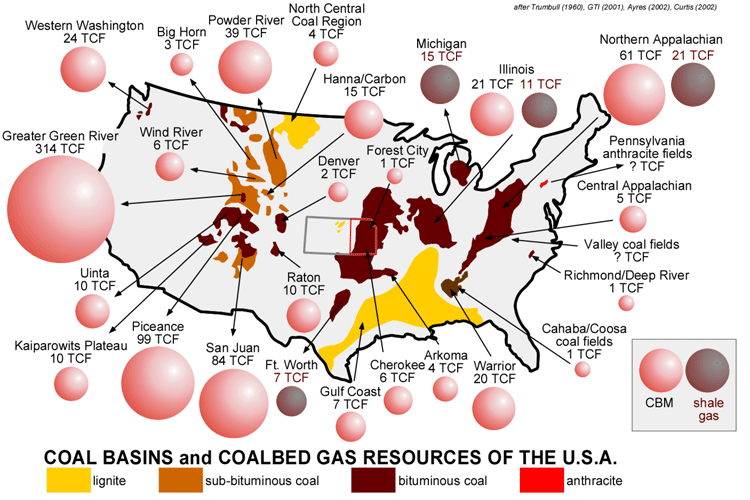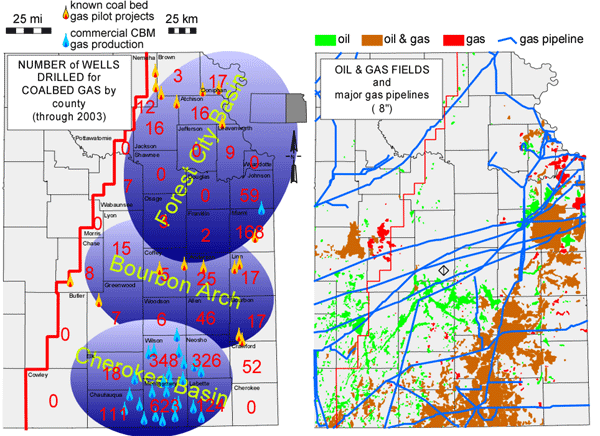 Geological and Geochemical Factors Influencing the Emerging Coalbed Gas
Play in the Cherokee and Forest City Basins in Eastern Kansas
Geological and Geochemical Factors Influencing the Emerging Coalbed Gas
Play in the Cherokee and Forest City Basins in Eastern Kansas
K. David Newell, Troy A. Johnson, W. Matthew Brown, Jonathan P. Lange,
and Timothy R. Carr
Kansas Geological Survey, University of Kansas
Open-File Report 2004-17
Open-File Report 2004-17
Abstract
Coals and black shales in the Middle Pennsylvanian Cherokee and Marmaton Groups
are becoming increasingly important commercial sources for unconventional
gas in eastern Kansas, with over 200 wells being drilled in the last two years.
Most of the development is in a five-county area in southeastern Kansas (i.e.,
Chautauqua , Labette , Montgomery, Neosho, and Wilson counties), but gradual
expansion of this production northward and westward is anticipated, particularly
along existing pipeline corridors. Initial data indicate that several coals
can be perforated and produced in an individual well, but overall gas content
may decrease NNE along regional strike and certainly eastward where strata
rise updip onto the Ozark dome. Although gas content of the coals generally
increases with depth and confining pressure to a maximum of 250 to 300 scf/ton,
some shallow coals at less than 700 feet in depth have unexpectedly large
gas contents (>100 scf/ton) exceeding that of immediately deeper coals.
Compositional (i.e., hydrocarbon gas wetness) and isotopic analyses (d13C,
dD for methane) for desorption and production gases suggest that a microbial
component to these gases may account for some of this local enrichment. Analyses
of conventionally-produced gases from Pennsylvanian and Mississippian reservoirs
in eastern Kansas indicate that these gases also can have a microbial component,
with a thermogenic influence increasing with increasing depth into the Cherokee
Basin. Unconventional gases are anticipated to also follow this pattern.
Coalbed Gas Development in Eastern Kansas

Higher gas prices, increasing demand for natural gas, and new technologies have turned coalbed gas into an active energy play in the U.S.A. Coalbed gas now represents approximately 8% of total dry gas production and 10% of dry-gas proved reserves of the U.S. (EIA, 2003). In the last two decades, the total coalbed gas production in the U.S.A. is in excess of 7 TCF -- a value of $156.1 billion at $2.23/mcf (Nelson, 1999). These values are expected to increase in the future.
Eastern Kansas comprises part of the Western Interior Coal Basin. The CBM potential of eastern Kansas is beginning to be realized, with major production starting in the early 90s.
Development Activity

Most coalbed gas development in eastern Kansas is in the Cherokee basin, in a five-county area near the Oklahoma state line -- Chautauqua, Labette, Montgomery, Neosho, and Wilson counties. Several pilot projects have been initiated farther north in the Bourbon arch and Forest City basin, but the economic viability of these pilot projects has yet to be determined. One outpost of commercial development, by Osborn Energy, is present just south of the Kansas City metropolitan area in southern Johnson/northern Miami counties.
e-mail : webadmin@kgs.ku.edu
Last updated May 2004
http://www.kgs.ku.edu/PRS/publication/2004/AAPG/Coalbed/P1-02.html